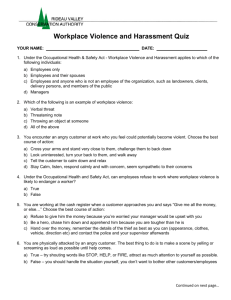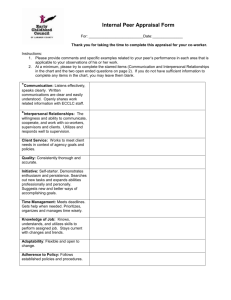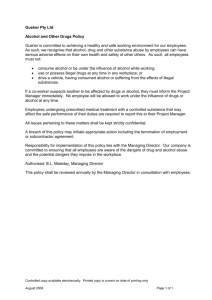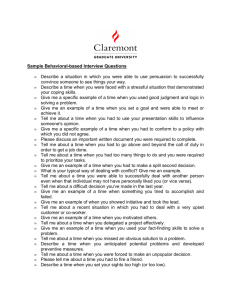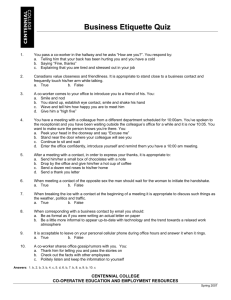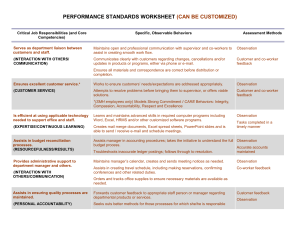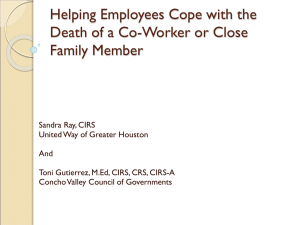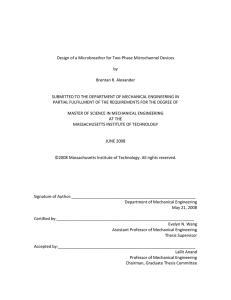CONFLICT RESOLUTION CURRICULUM ()
advertisement
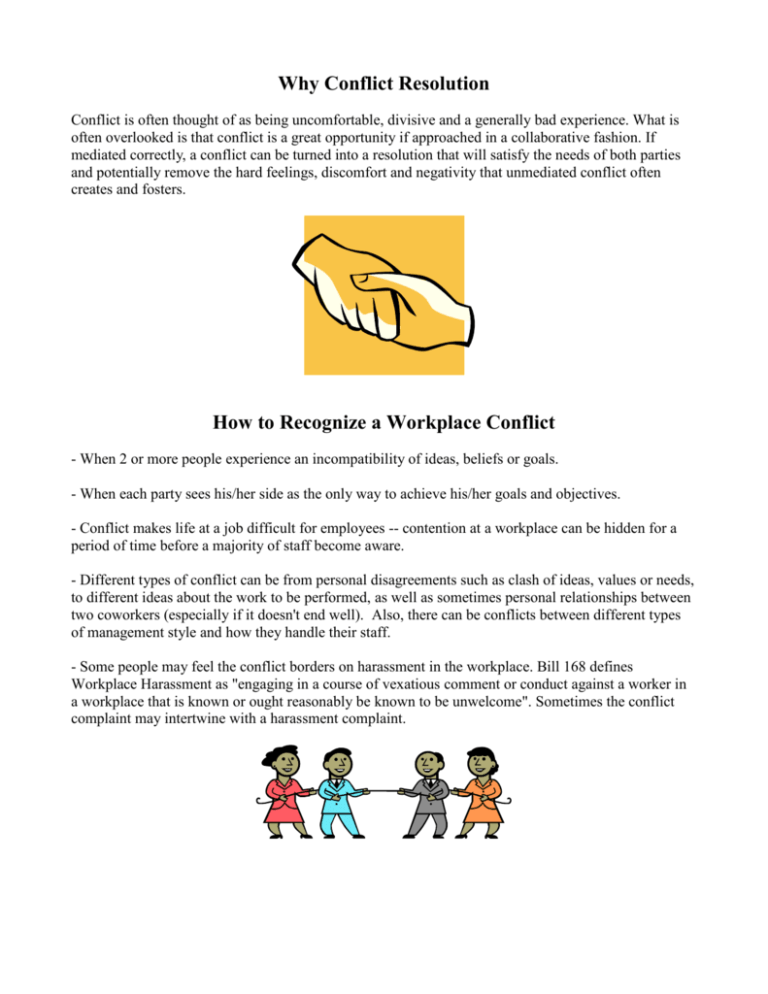
Why Conflict Resolution Conflict is often thought of as being uncomfortable, divisive and a generally bad experience. What is often overlooked is that conflict is a great opportunity if approached in a collaborative fashion. If mediated correctly, a conflict can be turned into a resolution that will satisfy the needs of both parties and potentially remove the hard feelings, discomfort and negativity that unmediated conflict often creates and fosters. How to Recognize a Workplace Conflict - When 2 or more people experience an incompatibility of ideas, beliefs or goals. - When each party sees his/her side as the only way to achieve his/her goals and objectives. - Conflict makes life at a job difficult for employees -- contention at a workplace can be hidden for a period of time before a majority of staff become aware. - Different types of conflict can be from personal disagreements such as clash of ideas, values or needs, to different ideas about the work to be performed, as well as sometimes personal relationships between two coworkers (especially if it doesn't end well). Also, there can be conflicts between different types of management style and how they handle their staff. - Some people may feel the conflict borders on harassment in the workplace. Bill 168 defines Workplace Harassment as "engaging in a course of vexatious comment or conduct against a worker in a workplace that is known or ought reasonably be known to be unwelcome". Sometimes the conflict complaint may intertwine with a harassment complaint. Basic Active Listening Skills Taken from Taft College: http://www.taftcollege.edu/lrc/class/assignments/actlisten.html When it comes to any situation, the ability to actively listen is all so important to our understanding of the situation(s), other people’s perspectives as well as a way for us to shape our own viewpoint. When engaged in conversation, there are five simple steps you can take to improve your active listening skills… Five steps to attentive listening (SOLER): Squarely face the person Open your posture Lean towards the sender Eye contact maintained Relax while attending (Eye contact; Posture, Gesture) All these physical adjustments are not just important as cues to the speaker that you are paying attention; they also help to shape your own thought process as an active listener. Some other easy tips to remember are: Don’t be afraid to ask for clarification. Repeating back what you heard in your own words is an excellent way to both re-affirm that you understood what was communicated to you correctly, and, to let the speaker know that you can express the idea, concept, perspective, etc. in your own words. Think about your exchange as a whole versus a bunch of disjointed statements. Summarizing the themes, key points/ideas and repeating them back to the speaker is an excellent way of expressing your comprehension of what has been communicated to you. Be respectful. As Stewards, you have a duty to represent the members in your workplace equally. Interpersonal disagreements must be put aside. Identifying Yourself as a Part of Conflict Resolution Before you even get to the point where you are trying to negotiate/mediate a conflict, it’s important that you do a self-assessment of yourself before entering into a potentially tense/volatile situation. Two basic questions to ask yourself are: Am I comfortable being the mediator/negotiator? Can I be impartial and objective in mediating the situation or is there something preventing this? As part of this self-assessment, it’s important that you establish your comfort level in relation to mediating the conflict/situation that is before you. If you feel you are unable to properly mediate/negotiate due to discomfort, you can defer to another mediator or negotiator you know of or speak to someone you trust to see if you can work through your own hesitations about approaching the situation to hopefully quell them. Impartiality and objectivity are two very important qualities to ensuring a successful resolution to a conflict. Recognizing your inability to be either/or is essential to respecting the process of conflict resolution. Pre-existing biases are typically something that can cloud a mediator/negotiators judgment. As well, past experiences that skew too similar to that which you are trying to resolve can also impair one’s ability to mediate/negotiate. Even if you are personally comfortable with the role of being a mediator/negotiator, if you feel that your impartiality and/or objectivity are compromised, it’s important to work through your barriers. Failing that, finding a replacement mediator/negotiator - if possible - is the best way to ensure a successful resolution. Dispute Resolution Model for Resolving Interpersonal Conflicts: The P.A.C.E. Method: Outlined below are a number of steps that you can use to effectively resolve outstanding issues when you are in conflict with another worker or a co-worker. Pause: Take a breather. Most of the time relationships can become strained when something is said out of anger or frustration usually in the heat of the moment. Let your co-worker know that you need to take a breather or a few minutes. By pausing and taking a break from the situation, you allow yourself to cool down and view the situation in a much more realistic and rational manner. Once you remove yourself from the situation, your co-worker will also be taking a breather, simply because you are no longer there. This can be done by going for a walk or having a cup of coffee or tea. Anything that will remove you from a tense situation for a few moments. Think about the meaning of the saying; “cooler heads will prevail.” Analyze: After you have taken some time to get away from the conflict situation and cool down, review what has transpired and think about how you should proceed. Consider the following questions when determining what course of action you should take: Who am I in a dispute with? What has the other party done that I do not like? What have I done that my co-worker might not like? Why do I feel the way I do? How is my co-worker feeling right now? Why would my co-worker do what they did? Why would I do what I did? What would I do if I was in their shoes? What kind of relationship do I have with my co-worker? Is this a relationship that I need to keep healthy? What expectations do I have for a resolution? Where are my interests and needs rather than my position and wants? Communicate: This is the most important part of the dispute resolution process. After both parties have taken a break to cool down and have analyzed the situation, let the other party know that you want to deal with the issues in a mature rational manner. Ask them if they are willing to take a few moments to talk about how and why there is a conflict. Based on your answers and thoughts to the questions you previously asked yourself, go into the discussion with an open mind and remain empathetic (remember that for every story, there is another side). Here are some tips to remember when communicating in a conflict situation: Use “I” statements when describing how you feel or think (e.g. rather than saying; YOU didn’t do that right, say I don’t think that was done properly. That keeps you from sounding like you are blaming the other person). Be empathetic (consider what it is like to be in the other person’s shoes). Focus on the future, not the past Consider what brings you together (what common ground do you share) Body language and tone of voice are the biggest elements for getting your point across (sit up straight, keep eye contact and use a positive tone of voice) By employing these guidelines, you are promoting a collaborative environment that should allow you to see where the other party is coming from, which will enable both parties to have a better understanding of each others points of view. Once both parties understand the other person’s point of view, coming up with a solution to the problem should be achievable. When trying to find solutions, be as creative as possible when brainstorming ideas for resolution. Put some ideas on the table that you think are realistic and build off of other ideas that are put forth. Evaluate: Once you have finished communicating with the other party, take a moment and evaluate what has transpired. Ask yourself if you are satisfied with the end result of your discussion and if not, what other course of action do you have as an option? Think about what you can do to prevent a dispute like this from occurring in the future. Source Material: Taken from the COPE Ontario Workshop “Dealing with Workplace Conflict” Resource Manual. To find out more information or to sign up for this or any other COPE Ontario workshop, check out http://copeontario.ca/education/workshops/
